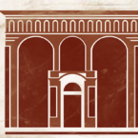by Erin Doane
On January 17, 1881, an enormous boulder was moved from the towpath on the east side of the former Chemung Canal near Latta Brook, down Lake Street, and over to Woodlawn Cemetery where it was placed on the plot owned by George S. McCann. Nine teams of horses and six yokes of oxen were used to move the immense stone. George wanted the boulder to mark his final resting place because he thought “an object formed by the hand of nature” was far more suitable as a monument for the dead than “a costly and ornate monument made by man.” It would be 19 more years before he joined his marker in the cemetery.

George S. McCann was born at the McCann homestead at 2,000 Davis Street on June 24, 1823. He was one of six children. His father John had come to Elmira from Ireland in 1809 and purchased 320 acres of land from Thomas Whitney. After John’s death, the family home went to George and he had a long, successful career as a farmer. In the 1870s, he sold 140 acres to the Commissioners of Prisons that became the site of the Elmira Reformatory.
On October 10, 1864, George married Crete Kingsbury. Together they had three children – Hattie, born September 4, 1865; Crete, born September 17, 1867; and James, born June 16, 1869. Less than three years after their son was born, however, tragedy struck. Crete passed away on March 4, 1872 at the age of 32. A notice in the local newspaper described her as “one of those sweet dispositioned women whom no one knows but to love, and her death will be mourned with genuine and heartfelt sorrow by a large circle of relatives, acquaintances and friends.” Funeral services were held at the McCann home and she was interred in Woodlawn Cemetery.

As a widower, George turned his attention to the community. Two years after Crete’s passing he got into politics. He was elected to the board of supervisors from the Town of Elmira in 1874, 1875, 1876, 1882, and 1883. He served as chairman of the board in 1882. He was also a member of the Union Lodge No. 95 Free and Accepted Masons, the Odd Fellows, the Independent Order of Good Templars, the Grange, and the Elmira Farmers’ Club.
George was known as someone who was always doing something to make others happy. On June 17, 1897, he hosted a reunion for those who had attended school with him back in the 1830s. Thirty-two of his former classmates along with their wives and husbands enjoyed a luncheon feast in a large tent in his front yard and shared stories of the good old days of their youth.

In 1899, George’s health began to fail and he became confined to his home. He made a trip to St. Clemens, Michigan to be treated for rheumatism but his condition did not improve. At seven o’clock in the morning on March 2, 1900, he passed away in the same house in which he had been born. The funeral was held at the homestead, as had been Crete’s, and he was laid to rest beside her in the plot marked by the enormous rock he had placed there so many years earlier.
Over time, the story of how the boulder was moved to Woodlawn became somewhat exaggerated, as many tales of great deeds are. It was reported that it took 17 teams of horses and four yokes of oxen to move it (which was a good 8 teams of horses more than stated in a document drafted on the day the stone was actually moved, but two fewer yokes of oxen.) The stone itself has been called the “largest common boulder ever found in the Chemung Valley.”

The monument also became a bit of a tourist attraction. An article in the Star-Gazette on September 13, 1895 encouraging visitors to enjoy the beauty of Woodlawn Cemetery specifically mentions “the immense boulder that bears the name of George McCann and his wife” as one of the sights to see while there. At some point, a large bronze plaque with the portraits of George and Crete and their death dates was added to the stone. Today, you can still visit the monument, which is located just down the hill from the Clemens family’s plot.
Erin Doane is the curator at the Chemung County Historical Society. For more information about the museum and to see more of their blog, click here.



0 Comments
Recommended Comments
There are no comments to display.